Sea Turtle Conservancy now has a certified Lighting Specialist I on staff! Lighting Project Manager Rachel Tighe recently received her Lighting Specialist I certification through the National Association of Innovative Lighting Distributors (NAILD).

STC Lighting Project Manager Rachel Tighe discusses a recently completed lighting retrofit with the General Manager & Operating Manager of the Holiday Inn Express Pensacola Beach.
The training allowed Rachel to increase her knowledge and gain expertise in lighting basics and luminaire application. This adds competence and confidence to the team and enhances STC’s ability to offer the best sea turtle friendly lighting solutions while maintaining human safety and security. We are now able to more effectively educate and communicate with property owners about the benefits of sea turtle friendly lighting.

The STC lighting team takes a meter reading and records the data in our online geodatabase system during a night evaluation in Perdido Key.
It is STC’s hope that the certification will help foster and maintain relationships with other lighting professionals in the industry. We are now better equipped to teach lighting professionals about sea turtle friendly lighting so they can better assist us in darkening sea turtle nesting habitat.
To learn more about STC’s Beachfront Lighting program, click here!
It’s that time of the year again; nesting season is here in the state of Florida! The majority of nesting in Florida occurs between May 1st and October 31st. About 90% of all sea turtle nesting in the United States takes place on Florida’s beaches, which means it is critical that residents and visitors alike do their part to ensure that sea turtles have a safe and successful nesting season. By reading the tips below, you can do your part to make sure they’re made part of your beach routine!

Loggerhead returns to sea after nesting (Photo Credit: Blair Witherington)
Use sea turtle-friendly lights or no lights at all! In order to prevent nesting and hatchling turtles from wandering off track, your beachfront property should use sea turtle friendly lighting. You can also help by closing drapes and blinds, and shield or turn off outdoor lights that are visible on the beach. Sea turtle hatchlings can become easily disoriented by bright lights on the coast from hotels and beachfront properties. By following these steps, you can encourage females to nest and lead hatchlings in the right direction, the ocean!

Tracks from disoriented hatchlings. Their tracks should lead straight to the sea.
Knock down sandcastles and fill in holes! Although this is every kid’s nightmare, it’s important to knock your sandcastle over and flatten out the sand at the end of the day. Additionally, filling in all holes made in the sand can avoid the entrapment of hatchlings while on their way to the water. Even the nesting mothers can become stuck in these holes when crawling up the beach to nest. Furthermore, remove all beach accessories, such as tents, umbrellas, toys, and chairs. These can prevent obstacles for both the mother and the hatchlings.
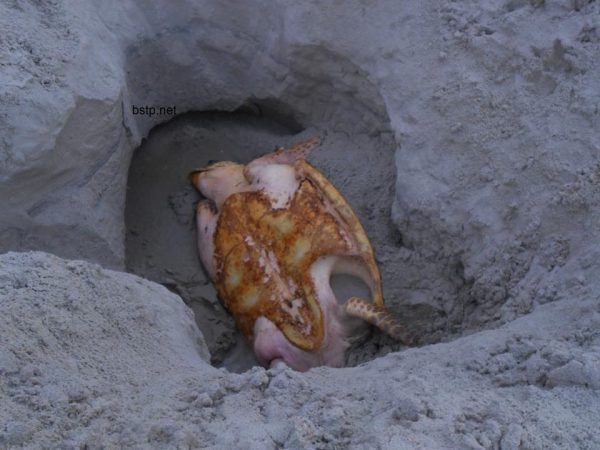
An adult loggerhead fell into a large hole on the beach and had to be rescued by Beaches Sea Turtle Patrol
Avoid the attraction of unwanted pests. Raccoon, foxes, coyotes and other types of animals all have one thing in common: they love our leftovers. Raccoons destroy thousands of sea turtle eggs each year and are one of the greatest causes of sea turtle mortality on Florida’s beaches. Leaving food outside for neighborhood dogs and cats also attracts raccoons. You can help deter these animals from destroying sea turtle eggs by cleaning up food and additional trash after a day at the beach.
Program the phone number for your area’s wildlife stranding hotline into your phone so you’ll be prepared if you happen to encounter a dead, sick, stranded or injured sea turtle. It is also important to report any harassment of sea turtles or disturbance of nests. In Florida, you can call FWC Wildlife Alert Number at 1-888-404-3922 or visit their website. For other states, you can find a list of contact info here.

Don’t interfere with the nesting or hatching process. It’s important to allow hatchlings to crawl to the water on their own. Many scientists believe the journey from nest to water allows them to imprint on their own beach. Picking up hatchlings may interfere with this process. It is also illegal to touch sea turtles under both federal and state laws.
Don’t place beach furniture too close to a marked nest. If possible, place furniture at least 5 feet away. Furniture can mislead turtles during the hatching process and also entrap them. Also make sure to put away your beach furniture at the end of the day as they become a dangerous obstacle for a nesting turtles.

Loggerhead turtle stuck under a chair that was left on the beach. Photo via Anna Maria Island Turtle Watch
Don’t use fireworks on the beach. Although this can be tempting with 4th of July right around the corner, think about how the loud noises and bright lights can disturb nesting females. Instead, many local organizations hold inland fireworks displays for your enjoyment. Bonfires on the beach also pose a danger to sea turtles.
If you would like to watch a nesting turtle, join an organized sea turtle walk. In Florida and other states where sea turtles nest, turtle watches are conducted by trained and permitted individuals. The goal is to educate people about sea turtles through direct contact, without disturbing the turtles. Click here for more information about registering to join an STC Turtle Walk.
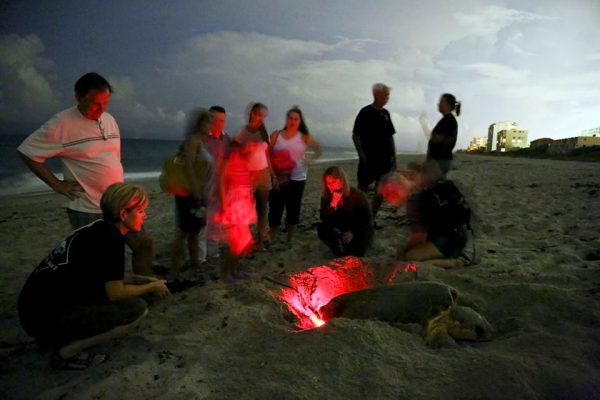
Photo courtesy Greg Lovett, Palm Beach Post (taken using long-exposure, no flash)
The Sea Turtle Grants Program (STGP), funded by the sale of Florida’s Helping Sea Turtles Survive specialty license plate, recently awarded $349,943.06 to 24 different projects benefiting Florida sea turtles as part of the 2018-2019 grant funding cycle.

Each year, the Sea Turtle Grants Program distributes money to coastal county governments, educational and research institutions and nonprofit groups through a competitive application process. The sea turtle specialty license plate is also the primary source of funding for the Florida Fish and Wildlife Conservation Commission’s Marine Turtle Protection Program.
The following organizations received grants for their approved projects for the 2018-2019 cycle:
The sea turtle plate is the number two overall selling specialty tag in Florida, and the number one environmental specialty plate. By purchasing the sea turtle specialty license plate, Floridians are voluntarily funding important programs to save endangered sea turtles and their habitats.
To learn more about the Sea Turtle Grants Program and the “Helping Sea Turtles Survive” specialty license plate, please visit www.helpingseaturtles.org.
The Sea Turtle Grants Program (STGP), funded by the sale of Florida’s Helping Sea Turtles Survive specialty license plate, recently awarded $362,564.95 to 29 different projects benefiting Florida sea turtles as part of the 2017-2018 grant funding cycle.

Each year, the Sea Turtle Grants Program distributes money to coastal county governments, educational and research institutions and nonprofit groups through a competitive application process. The sea turtle specialty license plate is also the primary source of funding for the Florida Fish and Wildlife Conservation Commission’s Marine Turtle Protection Program.
The following organizations received grants for their approved projects for the 2017-2018 cycle:
The sea turtle plate is the number two overall selling specialty tag in Florida, and the number one environmental specialty plate. By purchasing the sea turtle specialty license plate, Floridians are voluntarily funding important programs to save endangered sea turtles and their habitats.
To learn more about the Sea Turtle Grants Program and the “Helping Sea Turtles Survive” specialty license plate, please visit www.helpingseaturtles.org.
Sea Turtle Conservancy is proud to announce the release of a new documentary about sea level rise and its implications for sea turtles and their nesting beaches in Florida. “Ahead of the Tide” (AOTT) was co-produced by STC and CAVU, a non-profit that uses flight and film to educate people about critical conservation issues. AOTT highlights the effects of sea level rise and climate change on Florida’s beaches through the stories and voices of local Floridians. The video includes interviews with scientists, coastal engineers, elected officials, coastal planners, conservation leaders, authors and activists. As part of this project STC, CAVU, and a host of conservation partners will be sponsoring a series of webinars on climate change and sea level rise in the coming months. You can learn about and sign up for these webinars at Aheadofthetide.org.
Sea level rise will have serious and long term impacts to the state’s sea turtle nesting beaches. Our hope is that this powerful film will help to serve as a Call to Action for all Floridians to demand that our elected leaders, government agencies and coastal communities begin planning for sea level rise in order to protect Florida’s most valuable asset — its natural sandy beaches — both for sea turtles and for people. The state’s beaches belong to all Floridians; they define our state.
Sea Turtle Conservancy believes many specific actions can be taken and policies implemented to reduce the impacts of sea level rise and climate change on sea turtle nesting beaches while also helping to protect our beaches and to ensure coastal resiliency. Most importantly, we have to start making smarter decisions about how we manage our beaches and where we build along the coast – and where we rebuild as the seas continue to rise. Of the hundreds of pages that make up Florida’s coastal development and beach management laws there is virtually no mention of sea level rise, despite the fact that Florida’s beaches are among the most vulnerable in the nation to changes in sea level. Many of Florida’s elected leaders still deny the realities of climate change and resist any effort to plan for its impacts. We hope this video will help raise awareness and empower citizens to demand that our elected officials take action.
The 11th annual Endangered Species Day is May 20th, 2016! Endangered Species Day was created by Congress in an effort to raise awareness of the many endangered, threatened, and at risk species and the critical role they play in their environments.
Many zoos, parks, wildlife refuges, museums, schools and community centers, among other participants, will host educational events to promote and celebrate Endangered Species Day and the reasons behind its creation. To find an event near you, visit http://www.endangered.org/campaigns/endangered-species-day/

Endangered Species Day raises awareness about the many endangered species we have in our own communities. For example, did you know Florida has more endangered species than any other Atlantic state? Population growth coupled with habitat loss, tourism, and pollution are just a few factors that have imperiled many species in our state. In addition, Endangered Species Day is also a great time to celebrate success stories, like the recovery of the green turtle, the alligator, and the bald eagle.Thanks to the significant strides we have made under the Endangered Species Act, we are celebrating more and more success stories with each passing year.
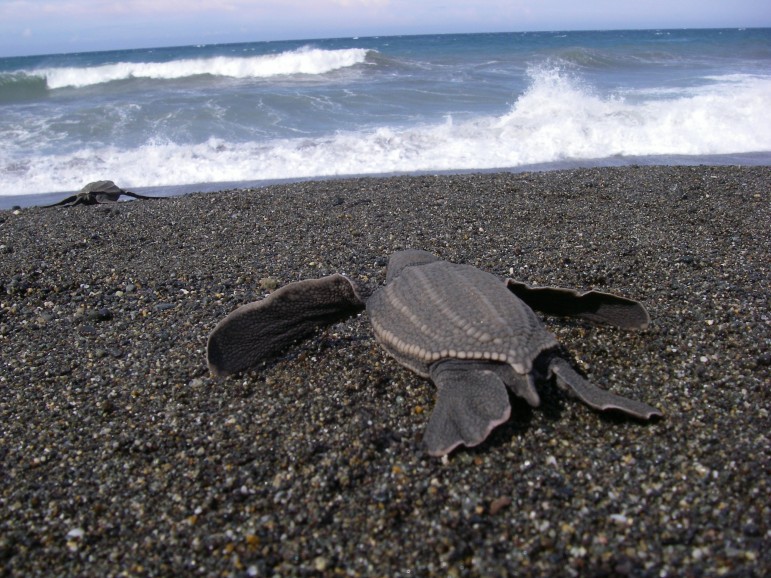
Photo retrieved from Endangered Species Coalition
For decades all sea turtles in U.S. waters have been listed under the Endangered Species Act, which was created in 1973.They are protected by the NOAA Fisheries in the ocean and by the U.S. Fish and Wildlife Service (USFWS) in their beach nesting habitats along U.S. coasts. In the United States threats to sea turtles include habitat loss, pollution and disease, boat strikes, entanglement in marine debris and accidental capture in fisheries. However, unlike other species of sea turtles, green turtles interact less with fisheries, which has contributed significantly to their recovery and made them an Endangered Species Act success story. During the nesting season of 1990, fewer than 50 green sea turtles were documented at the Archie Carr National Wildlife Refuge on Florida’s east coast. By 2005, there were just over 3,000 nests. In the most recent nesting season of 2015, green sea turtles set a new record with 14,152 nests! This comeback makes green turtles one of the greatest conservation success stories of our time. The species’ success can be attributed to the Endangered Species Act, STC and all other supporters who worked tirelessly to give green turtles a fighting chance.

Green Sea Turtle by Julie Suess
Sea turtles are not the only species that have had huge success stories thanks to the Endangered Species Act. Many species you may encounter on a regular basis in Florida were once on the brink of extinction. In the 1950s, the American alligator had nearly been hunted to extinction, but thanks to habitat protections and strong hunting regulations, their population from North Carolina to Texas has increased to about 5 million. The brown pelican was dramatically impacted by loss of habitat, but under the Endangered Species Act, they have made a strong comeback, and were officially removed from the endangered species list in 2009. Our national bird, the bald eagle, numbered in the hundreds in the 1960s, but with protection and the elimination of the pesticide DDT, which made eggs to fragile to hatch, its numbers have soared to over 14,000 breeding pairs today. The Endangered Species Act protects 1,357 species of animals (694 U.S. species) and 901 species of plants (898 U.S. species), and has prevented their extinction, which in turn helps to maintain healthy and sustainable ecosystems and a healthy planet.
On Endangered Species Day celebrate the Act’s successes and keep the momentum going!
1. Learn about endangered species
The best way to protect endangered species is learning about them and why they’re important. So teach yourself and educate those around you about the value of endangered species and why they are worth saving in their own right. STC’s educational program empowers sea turtle groups throughout Florida, provides educational materials and uses the concept of sea turtle migration tracking as an online educational tool. Learn more about endangered species by visiting the official site of the US Fish and Wildlife Service at www.fws.gov/endangered
 2. Visit a national wildlife refuge, park or other open space
2. Visit a national wildlife refuge, park or other open space
These places are home to a lot of different species, and preserving an endangered species’ habitat is essential to protecting the species. You can help by visiting a refuge close to where you live and become a volunteer. The Archie Carr National Wildlife Refuge in Florida is a major safe haven for sea turtles. About 25 % of Florida’s sea turtle nesting occurs in the Refuge.
3. Make your home wildlife friendly
Secure garbage in shelters or cans with locking lids and feed pets indoors to avoid attracting wild animals to your home. Taking these actions can keep animals like raccoons, which are sea turtle predators, away. Reduce your use of water in your home and garden so animals that live in or near water can have a better chance of survival. If you live on the beach you can make your home sea turtle friendly by implementing sea turtle lighting.
4. Plant native plants
Native plants provide food and shelter for native animals. You can plant sea oats on the beach to help prevent dune erosion and provide habitat for sea turtle nesting. STC conducts native dune vegetation planting to provide an additional buffer to reduce or eliminate unwanted light on the beach and to enhance nesting habitat at various project sites in the Florida panhandle.
5. Stay away from herbicides and pesticides
Herbicides and pesticides may keep yards looking nice, but they are in fact hazardous pollutants that affect wildlife at many levels. Many herbicides and pesticides take a long time to degrade and build up in soil and throughout the food chain. For alternatives to pesticides, visit http://www.beyondpesticides.org.
hazardous pollutants that affect wildlife at many levels. Many herbicides and pesticides take a long time to degrade and build up in soil and throughout the food chain. For alternatives to pesticides, visit http://www.beyondpesticides.org.

Photo by Robin Loznak
6. Slow down when driving
One of the main obstacles for wildlife in developed areas is roads. Animals that live in developed areas navigate in areas full of human hazards and roads present wildlife with a dangerous threat. So when you’re driving, slow down and be on the lookout for wildlife. You should also apply these practices while boating to avoid harming sea turtles and other endangered species in the water.
7. Recycle and buy sustainable products
Recycle anything that can be recycled and buy sustainable products as a simple gift to nature and its species. We love reusable glass straws from Strawesome and snack bags from LunchSkins!
8. Never purchase products made from threatened or endangered species
Overseas trips can be exciting and fun, and everyone wants a souvenir. But sometimes the souvenirs are made from species nearing extinction. Avoid supporting the market for illegal wildlife products such as tortoise-shell, ivory and coral. Hawksbill sea turtle shells are often used to be made into sunglasses, jewelry and other trinkets because of their beautiful shell pattern.
9. Stand up for wildlife
Harassing wildlife is cruel and illegal. Harmful behavior such as disturbing and distracting sea turtles is illegal and can be reported by calling any of the numbers listed on our website.
10. Protect wildlife habitat
Perhaps the greatest threat that faces many species is the widespread destruction of habitat. Environmental issues such as oil and gas drilling and development result in habitat destruction. Habitats belonging to endangered species should be protected so the impact on endangered species is minimized.
Any effort to help an endangered species is appreciated, so participate and celebrate national Endangered Species Day on May 20th, 2016!
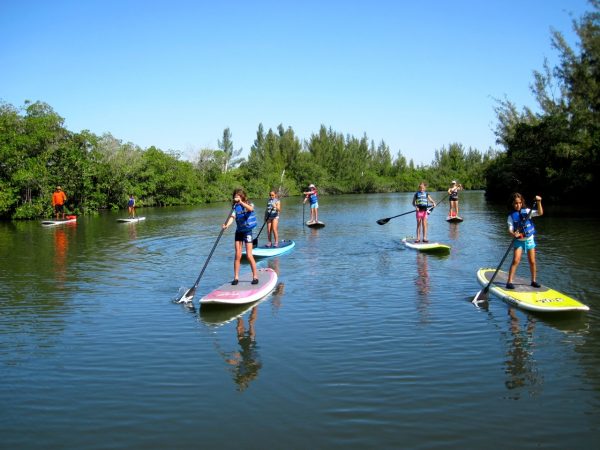
The Barrier Island Center, nestled in the heart of the Archie Carr National Wildlife Refuge in Melbourne Beach, Florida, is bringing back the Eco-Explorers Summer Camps program in 2016. The camps run throughout the month of June and are offered to children ages 9 to 15.

Participants will enjoy unforgettable experiences, from snorkeling to explore life below the ocean surface and kayaking and paddle boarding to observe first-hand the diversity of life on the Indian River Lagoon, to surfing to further connect with the very beach that attracts more nesting sea turtles than virtually any place on Earth.
Camp dates:
 Each session offered will cost $325 and includes transportation, certified aquatic instructors, equipment, t-shirt, a year-long Sea Turtle Conservancy honorary e-membership and a complimentary guided sea turtle walk with preferred reservation! To enroll, complete and fax THIS FORM to 321-952-3207. You may then call 321-723-3556 to make your payment. For more information, visit our website. Enrollment is limited to 13 per week and spots fill up quickly! For questions, please email donnalee@conserveturtles.org We hope to see you there!
Each session offered will cost $325 and includes transportation, certified aquatic instructors, equipment, t-shirt, a year-long Sea Turtle Conservancy honorary e-membership and a complimentary guided sea turtle walk with preferred reservation! To enroll, complete and fax THIS FORM to 321-952-3207. You may then call 321-723-3556 to make your payment. For more information, visit our website. Enrollment is limited to 13 per week and spots fill up quickly! For questions, please email donnalee@conserveturtles.org We hope to see you there!

The Sea Turtle Grants Program (STGP), funded by the sale of Florida’s Helping Sea Turtles Survive specialty license plate, recently awarded $311,649.72 to 24 different projects benefiting Florida sea turtles as part of the 2016-2017 grant funding cycle.

Each year, the Sea Turtle Grants Program distributes money to coastal county governments, educational and research institutions and nonprofit groups through a competitive application process. The sea turtle specialty license plate is also the primary source of funding for the Florida Fish and Wildlife Conservation Commission’s Marine Turtle Protection Program.
The following organizations received grants for their approved projects for the 2016-2017 cycle:
The sea turtle plate is the number two overall selling specialty tag in Florida, and the number one environmental specialty plate. By purchasing the sea turtle specialty license plate, Floridians are voluntarily funding important programs to save endangered sea turtles and their habitats.
To learn more about the Sea Turtle Grants Program and the “Helping Sea Turtles Survive” specialty license plate, please visit www.helpingseaturtles.org.

Sea Turtle Conservancy is proud to announce the release of a series of short videos about sea level rise and the need to protect Florida’s beaches in an era of rising seas. The video series, Ahead of the Tide, was produced in partnership with the nonprofit organization CAVU.
Sea level rise will have serious and long term impacts to the state’s sea turtle nesting beaches. Our hope is that this series of short, powerful films will help to serve as a Call to Action for all Floridians to demand that our elected leaders, government agencies and coastal communities begin planning for sea level rise in order to protect Florida’s most valuable asset — its natural sandy beaches — both for sea turtles and for people. Below is Chapter One – Florida’s Lifeblood.
Sea Turtle Conservancy believes many specific actions can be taken and policies implemented to reduce the impacts of sea level rise and climate change on sea turtle nesting beaches while also helping to protect our beaches and to ensure coastal resiliency. Most importantly we have to start making the right and smart decisions now. Of the hundreds of pages that make up Florida’s coastal development and beach management laws there is no mention of sea level rise despite the fact that Florida’s beaches are ground zero for impacts. We hope these videos will help raise awareness and empower citizens to demand that our elected officials take action. The state’s beaches belong to all Floridians; they define our state.
You can sign up to be alerted when future chapters of this series are released by visiting Aheadofthetide.org.
The holidays are near, which means it’s time to celebrate generosity and give! On December 1, 2015 Sea Turtle Conservancy (STC) will be participating for a third time in #GivingTuesday. #GivingTuesday provides one day to make a BIG difference!
STC needs your help on this special day to support the Barrier Island Center (BIC)! The BIC, located in Melbourne, FL in the heart of the Archie Carr National Wildlife Refuge, is an education and outreach center which provides free or low-cost programs to visitors, local schools and community members.
These programs help to educate the public about the important eco-systems of the barrier island, wetlands, and lagoon. These areas provide vital nesting and foraging habitat for sea turtles. Since the BIC opened in 2008 over 245,000 adults and children have been able to learn through hands-on activities such as Eco-Explorers summer camps, oyster mat making, sand dune planting, and much more.
Unfortunately, the BIC recently learned it would not be receiving an annual grant of $15,000 to help fund education programs and other operating costs.
Join the movement and help STC continue it’s efforts to further these educational programs.
Can we count you in for #GivingTuesday? Help us reach our $15,000 goal! Click here to participate!
This article originally appeared in Florida Today here.
MELBOURNE, Fla. — Four decades ago, biologists thought green sea turtles might go extinct. But this year, the endangered reptile dug a record number of nests at the Archie Carr National Wildlife Refuge, with two months still left in their nesting season.
“It’s an incredible thing,” said Llew Ehrhart, professor emeritus at University of Central Florida, who’s studied turtle nesting at Archie Carr since the 1980s.
In the 1970s, biologists could only find a handful of green sea turtles nests at Archie Carr and the Melbourne Beach area.
This year, UCF researchers counted 12,026 green turtle nests at Archie Carr refuge, already crushing a record the turtles set at the refuge in 2013 — 11,839 nests.
The nesting at Archie Carr is significant, because biologists consider that span of beach among the most important sea turtle nesting spots in North America and indicative of how turtle nesting is going as a whole.
In general, green sea turtles nesting has “on” years and “off” years, with the number of nests spiking every other year. So biologists anticipated an “on” year. But this is the first time green turtle nests surpassed 12,000 nests, UCF researchers said.
Nesting on the “on” years has ballooned, from 455 nests in 1988 to more than 8,400 nests by 2000.
And now they dig six times that amount of nests.
“This is really a comeback story,” Kate Mansfield, a UCF assistant professor of biology, said in a release. Mansfield leads a team of students and research scientists who monitor turtle counts on the beach during turtle nesting season, which runs May 1 to Oct. 1.
“It is a really remarkable recovery and reflects a ‘perfect storm’ of conservation successes,” Mansfield added, “from the establishment of the Archie Carr, to implementing the Endangered Species Act, among many other conservation initiatives. It will be very exciting to see what happens over the next 20 plus years.”
Green sea turtles are just one of three species that use the refuge as their nesting grounds.
Endangered leatherback and threatened loggerhead sea turtles also nest on Brevard County’s beaches.
Sea turtles dig about 80 percent of their nests in the United States. Archie Carr is home to one of the largest nesting beaches for loggerhead turtles in the Western Hemisphere, with among the highest density of nests.
Hatchlings paddle out against an ever-strengthening current of challenges, which only the fittest of every 10,000 fends off long enough to become an adult turtle.
The increase in green sea turtles nesting is four decades of conservation measures paying off, Ehrhart says.
Pressure from commercial fishing, diseases and habitat loss chipped away at the reptile’s numbers. Hatchlings wander into roads because of bright beach lights. In nations where their sweet-tasting meat is savored by the locals, the perils are worse.
Native Americans and early European settlers also once harvested green sea turtles for their meat.
But laws prohibiting the harvesting of sea turtles, excessive beach lighting and fishing nets that cause turtles to drown have helped their numbers rebound.
In 1978, the federal government listed the green sea turtle under the Endangered Species Act.
Green sea turtle populations in Florida and the Pacific coast of Mexico are listed as endangered. Elsewhere, the species is listed as threatened.
Sea Turtle Conservancy celebrated its 8th annual Tour de Turtles (TdT) with a live sea turtle release on August 2nd at the Barrier Island Center, located in the heart of the Archie Carr National Wildlife Refuge in Melbourne, Florida.
Hundreds of people gathered to watch STC researchers release two adult female loggerheads sea turtles, named “Myrtle” and “Dash”, into the ocean to begin their migrations. Myrtle was named by her sponsors at Ripley’s Aquariums and Dash was named by her sponsors at Shark Reed Aquarium. The event was sponsored in part by the Florida Sea Turtle License Plate.

This year 13 sea turtles, representing four different species, were swimming in the race to conduct valuable research and raise public awareness about sea turtles.
The 2015 TdT included live turtle releases in Panama, Costa Rica, Nevis and Florida. This year is the first time a nesting turtle was released from Florida’s West Coast. Loggerhead “Amie” was named by her sponsors from the Anna Maria Island Turtle Watch group and released in the Gulf of Mexico in June.
Before each turtle release, STC scientists attached a satellite transmitter to its shell using– safe epoxy or fiber class resin. The transmitter allows STC and the public to track the turtles as they travel and migrate from their nesting beaches to their foraging grounds.
Meet the competitors!
Calypso Blue IV, Leatherback
Sponsor: Atlantis Paradise Island
Cause: Commercial Trawl Fisheries
Myrtle, Loggerhead
Sponsor: Ripley’s Aquariums
Cause: Plastic Debris
Marina, Loggerhead
Sponsor: Disney Conservation Fund
Cause: Plastic Debris
Susie Q, Green Turtle
Sponsor: Turtle & Hughes, Inc.
Cause: Light Pollution
Dash, Loggerhead
Sponsor: Shark Reef
Cause: Commercial Longline Fisheries
Tinkerbell, Loggerhead
Sponsors: Disney’s Animal Protection Programs & Disney’s Vero Beach Resort
Cause: Water Quality
Millie, Hawksbill
Sponsor: Four Seasons
Cause: Water Quality
Insolites, Leatherback 
Sponsor: Continents Insolites SAS
Cause: Invasive Species Predation
Pawikan, Green Turtle
Sponsor: Pacsafe
Cause: Egg Harvest for Consumption
Luna, Hawksill
Sponsor: Four Seasons
Cause: Climate Change
Tiki, Hawksbill
Sponsors: Treadright Foundation & Contiki
Cause: Illegal Shell Trading
Aaron, Loggerhead
Sponsor: The Turtle Hospital
Cause: Boat Strikes
Amie, Loggerhead
Sponsor: Anna Maria Island
Cause: Beach Erosion
Turtle fans can follow the turtle’s migration online at www.tourdeturtles.org, and cheer on their favorite competitor while learning the threats that sea turtle face. Fans can support their favorite turtle online by virtual adopting, tweeting, or making a pledge for every mile the turtle swims. The turtle who swims the farthest by October 31 will be crowned the winner of the “race”. while the turtle who raises the mist support online, will be crowned the “People’s choice winner”.
Sea Turtle Conservancy is excited to have our friends from Ripley’s Aquariums sponsor a turtle in this year’s Tour de Turtles for the third year in a row! Last year, Ripley’s sponsored a loggerhead turtle named Shelley who was released from the Barrier Island Center (BIC) in Melbourne Beach. Shelley swam 761 km and came in 2nd place in the People’s Choice Award Competition! This year, Ripley’s sponsored turtle will be released from the BIC on Sunday, August 2nd and her name is…. MYRTLE!
To decide on a name for their turtle, each of the three Ripley’s Aquariums submitted a name. Those names were then voted on by Ripley’s fans. More than 6,000 online votes were received and Myrtle (submitted by Ripley’s Aquarium in Myrtle Beach) was chosen as the winner! During this year’s race, Myrtle will be swimming to raise awareness about the threat of plastic debris.
For more than 90 years, Ripley Entertainment, Inc. has entertained visitors around the world, with more than 90 attractions in 10 countries. Ripley Entertainment’s three aquariums in Myrtle Beach, SC, Gatlinburg, TN, and Toronto, Canada have educated millions of visitors. In the next decade, Ripley’s plans to open more aquariums in tourist markets throughout North America and the world.
 Ripley’s mission is to provide an immersive experience into the aquatic world while fostering education, conservation and research. The three aquariums are each home to more than 10,000 exotic sea creatures such as sting rays, sharks and jellyfish, which entertain, inspire and encourage visitors to respect and protect the waters of the world.
Ripley’s mission is to provide an immersive experience into the aquatic world while fostering education, conservation and research. The three aquariums are each home to more than 10,000 exotic sea creatures such as sting rays, sharks and jellyfish, which entertain, inspire and encourage visitors to respect and protect the waters of the world.
Each of the Ripley’s Aquariums are home to non-releasable green sea turtles that swim alongside sharks, moray eels and fish. There is one turtle at Ripley’s Aquarium of Myrtle Beach, one at Ripley’s Aquarium of Gatlinburg and two at Ripley’s Aquarium of Canada. All four turtles receive consistent and excellent care overseen by Dr. Robert George, Ripley’s Chief of Veterinary Services. Ripley’s sea turtle exhibits help educate the public and raise awareness about the threats that sea turtles face.
The past two Ripley’s turtles in the Tour de Turtles race have raised awareness about the dangers sea turtles face from longline fisheries. The turtles, attracted to the bait, get caught on the hooks used to catch fish. Loggerheads face higher risk to longline fisheries than most species of sea turtles because of their feeding habits.
Ripley’s is currently involved in numerous conservation efforts such as the AZA’s Party for the Planet/Earth Day Celebration and Species Survival Program, as well as participation in International Coastal Cleanup and other local community cleanups. Ripley’s Aquarium Conservation Team is partnering with the North Myrtle Beach Sea Turtle Patrol to help monitor sea turtle nests along previously unmonitored portions of the beach. Other actions include partnership with the organization Ocean Wise to support sustainable seafood and efforts to reduce in-building energy and water usage.
One of Ripley’s Aquariums main goals is to promote conservation and protection of marine wildlife, and Tour de Turtles is an excellent way to achieve this goal! Ripley’s especially feels that it is important to support sea turtle conservation efforts and sees Tour de Turtles as a way to engage and educate guests about sea turtles.
STC would like to thank Ripley’s Aquariums for its continued support of our Tour de Turtles program!
This is a guest post written by Hannah Helsabeck. Hannah is President and Co-Founder of WildMintShop.com, an online shop dedicated to helping families find toxin-free and Eco-friendly products for healthier lifestyles.
Summer vacations are a great opportunity to toss your cares away, have major fun in the sun, and create lots of memories with family and friends. If you seek beaches, campgrounds, or pretty much anywhere outside of the concrete jungle to relax, you’ll want to make sure you’re not leaving anything behind that can harm wildlife as you’re becoming one with nature.
It is estimated that more than 100 million marine animals are killed each year due to plastic debris in the ocean and that more than 80 percent of this plastic comes from land. When we throw away or litter plastic items, they can wash out to sea from beaches, streets, and landfills. This pollution often kills wildlife like our precious sea turtles when they ingest it or become entangled in it. That’s why it’s so important to reduce the amount of plastic garbage we produce and seek safer, eco-friendly alternatives.
It’s our responsibility to reflect about the impact we all have on the environment that we share with other animals and there are lots of easy ways to live more eco-friendly lives. So, as summer approaches, here are 5 simple ways to have a greener (and more sea turtle friendly!) summer vacation:
 Water bottles. A huge offender when it comes to plastic waste is the use of disposable plastic water bottles. Staying hydrated is crucial, but there’s a better way to do it: switch to reusable water bottles. To shy away from plastic bottles and the potentially toxic chemicals used to make them, choose alternatives like glass water bottles or stainless steel instead. Simply refill with your favorite drinks and reuse for all of your adventures. By making the switch you can help protect our planet, avoid chemicals like BPA/BPS, and reduce your amount of plastic waste.
Water bottles. A huge offender when it comes to plastic waste is the use of disposable plastic water bottles. Staying hydrated is crucial, but there’s a better way to do it: switch to reusable water bottles. To shy away from plastic bottles and the potentially toxic chemicals used to make them, choose alternatives like glass water bottles or stainless steel instead. Simply refill with your favorite drinks and reuse for all of your adventures. By making the switch you can help protect our planet, avoid chemicals like BPA/BPS, and reduce your amount of plastic waste.
Food containers and baggies. Bringing your own food with you while traveling on vacation is a great way to stay healthy and save money, but plastic containers and bags are not so great for the environment. Plastic bags, big and small, are a huge contributor to marine pollution. Plastic does not biodegrade, meaning that the bag you use once and throw away is sticking around somewhere for a very, very long time. The best way to help reduce this plastic pollution is to completely avoid buying these products and instead opt for non-plastic, reusable sandwich bags and glass food containers (like the one shown with the kiwi turtle!) to pack foods.
Sea turtle friendly summer vacation spots. If you plan on visiting the beach or staying at a hotel on the water, you can check to see if it is sea turtle friendly, meaning that the facility supports conservation through its lighting policies and educational activities. Click here to learn which vacation spots get the STC seal of approval!
Natural sun protection. Protect your family from the chemicals found in many sunscreens on the shelf by doing a little more research and choosing natural sunscreen and insect repellent. These mineral-based sunscreens reduce your exposure to the harsh chemicals that can mimic hormones once absorbed in the body found in chemical sunscreens. These products also help to keep these toxic chemicals out of the environment so both plant and animal species can avoid exposure as well.
Straws. Nothing makes a drink feel extra special than a fun straw! Unfortunately, single use disposable straws add to the harmful effects of plastic pollution on the environment. Thankfully there are reusable straws made with stainless steel and glass that are beautiful and eco-friendly. Now you can pop a festive straw in your tropical drink and enjoy knowing that your sustainable choice makes a difference for the better.
In celebration of summer vacations and eco-friendly fun, Wild Mint Shop would like to offer a special discount to Sea Turtle Conservancy readers. Please enjoy 10% off all purchases through June 30, 2015 by using the coupon code TURTLES at checkout. You can find a variety of the reusable and non-toxic products listed in this article and more on Wild Mint Shop.com.
It’s been 20 years since Sea Turtle Conservancy (STC) led the successful campaign to create a sea turtle license plate in Florida. Now, two decades later, the Helping Sea Turtles Survive license plate is the top selling environmental plate in the state. Revenue generated by the sea turtle tag stretches a long way. Seventy percent of the plate’s proceeds fund the Florida Fish and Wildlife Conservation Commission’s Marine Turtle Protection Program (MTPP). The remaining funds are routed through STC, which distributes funding annually through the Sea Turtle Grants Program (STGP). Since its establishment, the STGP has been able to award more than $4 million in grants to more than 230 sea turtle research, conservation and education projects (http://www.helpingseaturtles.org/index.php)
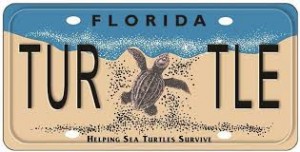 Many other states have similar license plates that also help raise money for sea turtles or local wildlife. Check out our list below!
Many other states have similar license plates that also help raise money for sea turtles or local wildlife. Check out our list below!

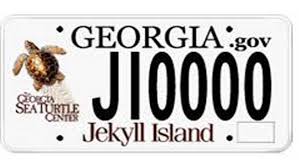






Many states have some sort of wildlife conservation specialty license plate, and this is not a comprehensive list. If your state doesn’t offer a wildlife conservation plate, or even if you just want to add some sea turtle love to your vehicle, check out our replica sea turtle license plate! It can be added to the front of your vehicle, the window or anywhere you see fit and is just $12.95.
You can also purchase a sea turtle frame for your standard license plate from Blue Marlin License Frames. Ten percent of each purchase is donated to STC! 
75% of Florida voters approved Amendment 1 in November 2014. However, over the past 7 weeks of the Florida Legislative Session, Amendment 1 has run into resistance from leaders in both the House and Senate. The Florida Legislature should trust that the voters knew exactly what they were approving with Amendment 1.
Now is the time to renew our pleas for increased spending from Amendment 1 for parks and wildlife habitat. The Senate budget offers a stingy $37 million for land acquisition, partly targeted to springs.
Against the Senate budget, Governor Scott’s budget offers a compelling framework for funding conservation needs. However, neither the House or Senate budget leaders support the governor’s A-1 spending plan.
The Governor’s budget proposes, and will put in permanent law, the following:
• $150 million annually for land acquisition and improved land management
• $150 million for the Everglades and a $5 billion pledge over 20 years
• $50 million for Springs recovery and a $1.6 billion pledge over 20 years
 The Governor’s budget numbers line up favorably with the Water and Land Amendment Coalition’s proposal and fit with strategies to support existing Florida Forever priorities and Everglades restoration plans.
The Governor’s budget numbers line up favorably with the Water and Land Amendment Coalition’s proposal and fit with strategies to support existing Florida Forever priorities and Everglades restoration plans.
Surveys show that the voters clearly knew and expected that Amendment 1 money would fund the state’s Land Acquisition Trust Fund to acquire land for conservation, habitat, parks and water resources protection.
Keep contacting your Representatives and Senators to reinforce that message. Click here to find their contact information.
If you call, please say: “Please support the using Amendment 1 fund to acquire land for parks, habitat, water resources, and to protect the Everglades and coastal areas.”
We have about 10 days left to let our elected leaders know that they must fully fund Florida Forever! In addition to contacting your legislators, please also contact Governor Scott and these key legislators involved in the budget process TODAY and tell them to fully fund Florida Forever!
Here is who you can contact:
It only takes a few minutes to make the call or email. Every call is a reminder to our legislators that they are accountable to the voters. We know how invested you are in seeing more money go toward protecting our environment and conserving the natural treasures we hold dear. That is the purpose of Amendment 1. For more info and resources, check out Florida’s Water and Land Legacy page.